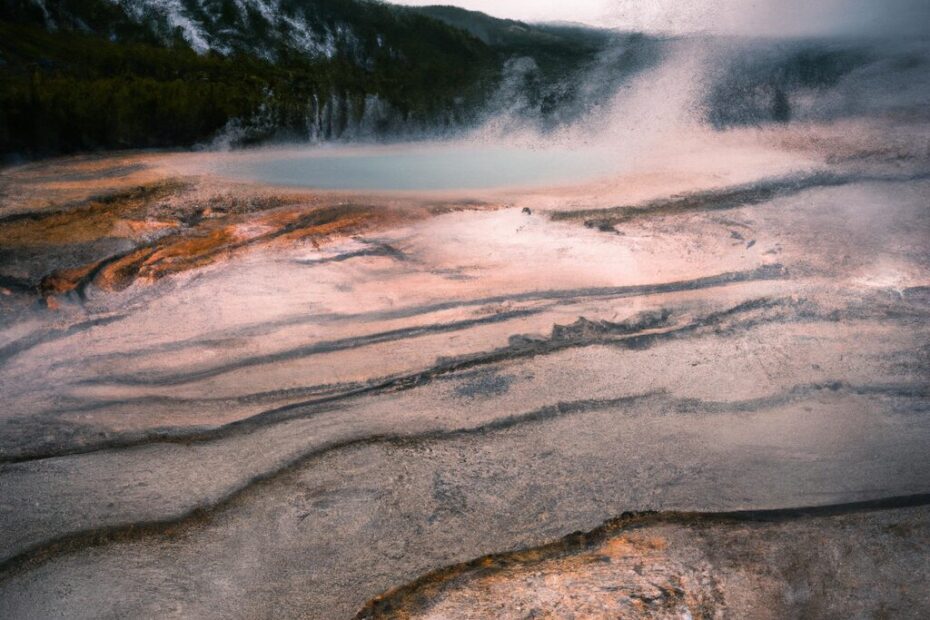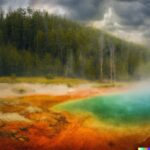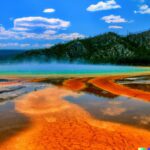Yellowstone National Park is famous for its stunning geysers, natural hot springs that shoot water and steam into the air. But have you ever wondered how these geysers are formed, what makes them unique, and where the hottest ones are located?
In this article, we will explore the fascinating world of Yellowstone geysers, including their formation, eruption causes, effects on the environment, and even whether it’s safe to swim in them. So, grab a cup of tea and join us on this exciting journey to learn more about the wonders of Yellowstone geysers!
What Are Yellowstone Geysers?
Yellowstone geysers are natural hydrothermal features found in Yellowstone National Park, known for their spectacular display of erupting boiling water and steam, shaped by geological processes and volcanic heat.
The geysers found in Yellowstone National Park are a direct result of the park’s location above the Yellowstone hotspot. This geothermal hotspot generates intense heat beneath the Earth’s surface.
The deep underground water is heated by this geothermal activity, causing it to rise and interact with the cooler water above. This interaction results in the awe-inspiring eruptions that can be seen throughout the park. It is the unique combination of heat, pressure, and water within the hydrothermal system of Yellowstone that gives rise to this mesmerizing natural phenomenon, attracting visitors from all over the world to witness its dynamic and captivating display.
How Are Yellowstone Geysers Formed?
The formation of Yellowstone geysers is intricately linked to the region’s volcanic activity, where the presence of magma and geothermal energy interacts with the landscape, shaping unique geologic features and contributing to the creation of mesmerizing geysers.
What Makes Yellowstone Geysers Unique?
Yellowstone geysers stand out as unique natural wonders, influenced by the park’s supervolcano, and presenting captivating geologic phenomena and remarkable geothermal features that fascinate visitors from around the world.
Their distinctive association with the supervolcano, Yellowstone’s geysers offer a rare glimpse into the Earth’s geothermal activity, showcasing the interplay of water, heat, and geological formations. The dynamic eruptions and colorful mineral deposits enhance the visual spectacle, making each geyser a living testament to the awe-inspiring forces shaping our planet.
Visitors are drawn to the ethereal beauty and unpredictability of these geysers, which form an integral part of the park’s enchanting landscapes and contribute to its status as a global treasure of geologic wonders.
Where Are the Hottest Yellowstone Geysers Located?
The hottest Yellowstone geysers are predominantly located within the geothermal areas of the park, characterized by scorching hot springs, intriguing geologic formations, and intense thermal activity that exemplify the geysers’ extreme heat.
Within these geothermal areas, notable locations such as the Upper Geyser Basin, home to the iconic Old Faithful geyser, showcase mesmerizing displays of thermal activity.
The Norris Geyser Basin, with its diverse geologic formations, also boasts some of the hottest geysers in the park. The Mammoth Hot Springs area is renowned for its unique terraces formed by the accumulation of mineral deposits from hot springs, adding to the park’s unique geologic wonders shaped by significant thermal activity.
What Is The Temperature Of The Hottest Yellowstone Geyser?
The temperature of the hottest Yellowstone geyser is so extreme that it requires advanced thermal imaging techniques to accurately measure the intensity of its geothermal heat, showcasing the powerful geologic processes at play within the geyser.
This exceptional temperature provides a glimpse into the incredible forces shaping the geological landscape of Yellowstone. Thermal imaging allows scientists to observe the inner workings of these geysers, aiding in understanding the underlying geologic processes.
It is crucial for studying the heat distribution and monitoring any changes in the geyser’s behavior, offering valuable insights into the dynamic nature of geothermal systems. This advanced technology plays a pivotal role in unraveling the mysteries of Yellowstone’s geology and the earth’s geothermal energy potential.
What Causes Yellowstone Geysers to Erupt?
Yellowstone geysers erupt due to the buildup of pressure from steam vents and the underlying geothermal activity, culminating in awe-inspiring geyser eruptions that showcase the park’s remarkable geologic wonders.
Geysers are natural wonders that are created by a delicate balance of factors. The Earth’s mantle produces intense heat which warms water, resulting in steam that seeks release through vents. As pressure builds, the steam forces its way up, causing the geyser to erupt in a thrilling display of boiling water and steam.
This breathtaking spectacle never fails to capture the attention of visitors, providing a glimpse into the captivating forces at work beneath the Earth’s surface.
How Often Do Yellowstone Geysers Erupt?
Yellowstone geysers exhibit varying eruption frequencies, influenced by the underlying geologic processes, the presence of thermal springs, and the dynamic interplay of geothermal activity within the park’s geysers.
Geologic processes have shaped the eruption patterns of Yellowstone geysers over thousands of years. The constantly circulating heated water in the thermal springs is crucial for maintaining the heat needed for geyser eruptions. The interplay of geothermal activity adds another layer to this intricate process, resulting in the mesmerizing bursts of water and steam that captivate visitors.
By understanding these natural forces, we can truly appreciate the awe-inspiring phenomena of Yellowstone’s geysers. The unique combination of geologic and geothermal activity creates a truly remarkable experience for all who visit.
What Are the Different Types of Yellowstone Geysers?
Yellowstone geysers encompass diverse types, including fountain geysers, cone geysers, and basin geysers, each presenting unique characteristics and contributing to the park’s hydrothermal allure.
Fountain geysers, such as the famous Castle Geyser, are known for their tall, dramatic eruptions, shooting water high into the air.
Cone geysers, like the Old Faithful, have a cone-shaped formation surrounding the vent, and they exhibit regular and predictable eruptions, attracting numerous spectators.
Basin geysers, such as the Great Fountain Geyser, are characterized by their large, shallow basins and infrequent but powerful eruptions, showcasing the diverse and captivating nature of Yellowstone’s geothermal wonders.
Fountain Geysers
Fountain geysers at Yellowstone National Park are characterized by the dramatic release of steam jets and their presence within distinct geothermal areas, contributing to the park’s captivating geologic features and hydrothermal allure.
Geysers are a crucial part of Yellowstone National Park, known for their frequent and powerful eruptions. These eruptions, which shoot water and steam into the air, create stunning displays that draw in visitors from all over the globe.
These geysers are closely tied to specific geothermal areas, showcasing the dynamic nature of the park’s hydrothermal systems. They are essential in comprehending the geological processes at work in Yellowstone.
Cone Geysers
Cone geysers within Yellowstone National Park are distinguished by their unique cone-shaped formations and their association with mesmerizing geologic features and captivating geothermal phenomena that contribute to the park’s allure.
These cone geysers, each with their distinct shape and size, play a vital role in showcasing the rich geologic formations that have evolved over time. Their significance lies in their ability to offer a window into the earth’s dynamic forces, evident through the ongoing thermal activities.
These formations enrich the park’s hydrothermal landscape, attracting visitors and researchers alike to explore and appreciate the natural wonder of these unique geologic features.
Basin Geysers
Basin geysers at Yellowstone National Park are notable for their presence within the park’s intriguing basins, contributing to the showcase of geologic wonders and captivating geothermal phenomena that define the park’s diverse hydrothermal landscape.
The unique location of these basins allows visitors to witness the power of nature firsthand. As geysers erupt with impressive force, plumes of hot water and steam shoot into the sky, creating a mesmerizing display.
The interplay of colorful mineral deposits and the varying shapes of the basins only adds to the visual spectacle, making the experience truly unforgettable for all who explore these natural marvels.
What Are the Effects of Yellowstone Geysers on the Surrounding Environment?
Yellowstone geysers exert significant effects on the surrounding ecosystem, influenced by the interplay of geothermal activity and the release of volcanic gases, shaping the environment and impacting the park’s ecology.
This unique combination of geothermal activity and volcanic gases creates a dynamic and ever-changing environment in Yellowstone National Park. The geysers and hot springs play a crucial role in shaping the landscape, altering soil composition, and affecting plant life.
The release of volcanic gases introduces various chemical elements into the ecosystem, influencing the behavior of flora and fauna. The temperature variations caused by geysers and hot springs create microhabitats that support a diverse range of organisms, contributing to the overall richness of the park’s ecology.
How Do Yellowstone Geysers Affect the Ecosystem?
The impact of Yellowstone geysers on the ecosystem is a subject of study by geophysicists, who aim to understand the influence of geothermal heat and the interaction of geologic wonders with the park’s ecology.
Geophysicists are delving into the intricate web of connections between the subterranean forces shaping the geysers and the surrounding environment. Through analyzing thermal gradients, fluid movement, and mineral deposits, they uncover valuable insights into the geysers’ effects on soil composition, plant growth, and animal habitats. This research plays a pivotal role in comprehending the holistic dynamics at play within this unique ecosystem. It also guides conservation efforts and enhances our understanding of nature’s intricate tapestry.
What Are the Dangers of Yellowstone Geysers?
While captivating, Yellowstone geysers pose inherent dangers due to the dynamic nature of geologic formations and the presence of intense geothermal phenomena, requiring caution and awareness when exploring the park’s hydrothermal features.
The spectacular geysers, formed by the accumulation of mineral deposits and the underground pressure of boiling water, can erupt with tremendous force and reach scalding temperatures.
The unstable ground around these geysers can give way unexpectedly, leading to potentially hazardous situations. Visitors need to exercise prudence in adhering to marked paths and avoiding venturing into restricted areas to ensure their safety.
Understanding the unpredictable nature of these features is crucial for enjoying the marvels of Yellowstone while minimizing risks.
Can You Swim in Yellowstone Geysers?
Swimming in Yellowstone geysers is strictly prohibited due to the extreme temperatures of thermal pools and the hazardous nature of geothermal vents. This ensures visitor safety and the preservation of the park’s natural wonders.
Yellowstone’s geysers are a sight to behold, but their scorching temperatures make them a dangerous place to swim. These geothermal vents, responsible for the breathtaking geysers, emit boiling water and toxic gases.
That’s why strict regulations are in place to protect visitors from potential harm and maintain the delicate balance of this unique ecosystem. By respecting these guidelines, visitors not only keep themselves safe, but also contribute to the longevity of the park’s mesmerizing landscapes and geothermal features.
What Precautions Should Be Taken When Visiting Yellowstone Geysers?
When visiting Yellowstone geysers, it is essential to adhere to safety precautions, stay on designated paths during geology tours, and maintain distance from steam vents and active geothermal areas to ensure a secure and enriching experience within the park.
This ensures not only your personal safety but also the preservation of the delicate environment.
The thermal features in Yellowstone can be unpredictable, and straying from designated paths can lead to accidents or damage to the geothermal formations.
By following the established guidelines, visitors can appreciate the natural beauty while minimizing their impact on the ecosystem.
Respecting the boundaries set for protection also demonstrates our responsibility as stewards of this unique natural wonder.
How Can You Learn More About Yellowstone Geysers?
To delve deeper into the fascinating world of Yellowstone geysers, visitors can partake in geology tours and educational programs that offer insights into the park’s geologic wonders and the captivating phenomena of geothermal activity, providing an enriching learning experience.
Experience the geological wonders of Yellowstone through our immersive tours and programs. Gain a profound understanding of the natural processes that shape the park’s landscapes.
With expert guidance and interactive learning, witness breathtaking displays of geothermal activity and develop a deep appreciation for the powerful forces at work beneath the Earth’s surface. These educational opportunities foster wonder and curiosity, creating an unforgettable and enlightening visit to Yellowstone.
Frequently Asked Questions
What is the average temperature of Yellowstone geysers?
The average temperature of Yellowstone geysers is around 160°F (71°C).
How hot can Yellowstone geysers get?
The hottest Yellowstone geyser recorded is the Steamboat geyser with a temperature of 204°F (95.6°C).
What makes Yellowstone geysers so hot?
Yellowstone geysers are hot due to the geothermal activity underground, which heats up the water and creates the pressure needed for eruptions.
Are there any risks associated with the high temperatures of Yellowstone geysers?
Yes, the high temperatures of Yellowstone geysers can be dangerous for humans if they come into direct contact with the hot water. Always follow safety precautions and warning signs when visiting geysers.
Can the temperature of Yellowstone geysers change?
Yes, the temperature of Yellowstone geysers can fluctuate due to changes in the underground geothermal activity. This can also affect the frequency and intensity of geyser eruptions.
Are there any ways to measure the temperature of Yellowstone geysers?
Yes, scientists use thermal sensors and instruments to measure the temperature of Yellowstone geysers. This data is used to monitor the geyser activity and predict eruptions.
Last Updated on January 25, 2024 by Jon Waraas – Originally Posted: January 25, 2024

I’m Jon Waraas, and I’ve been navigating the online world since 2006. By day, I’m the proud owner of some eCommerce gems, and by night, I’m the voice behind the adventures on Waraas.Com.
My heart, however, belongs to the wild beauty of Yellowstone National Park. I’ve got a collection of websites dedicated to sharing the wonders of this natural masterpiece. Oh, and did I mention? I’m currently building my own cabin inside the ghost town of Gilmore, Idaho – a cabin with tales to tell!
When I’m not immersed in the digital realm, you’ll find me lacing up my boots for a good hike or setting up camp under the star-studded sky.




